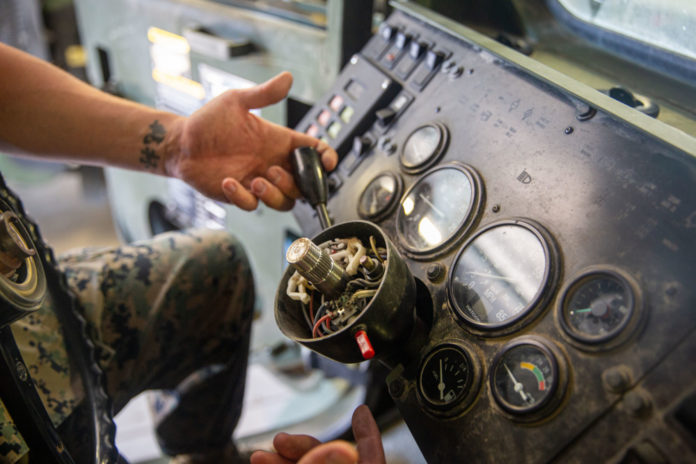Marine Corps System Command’s Advanced Manufacturing Operations Cell collaborated with 1st Supply Battalion and industry partners to develop a 3D-printed metal steering wheel removal device. This solution helps solve a common problem among vehicle maintenance Marines.
“We’re always talking about how Marines move toward the sound of gunfire,” said Capt. Matthew Audette, AMOC project officer at MCSC. “If we open up that aperture a little bit, we can say Marines move toward the sound of problems, and they solve those problems. Additive manufacturing lowers the barrier to entry for physically making that solution.”
Marines need to remove the steering wheel columns for the Medium Tactical Vehicle Replacement and Logistics Vehicle System Replacement when conducting vehicle maintenance. The removal tool that comes with their maintenance kit, a 10-way slide hammer, requires users to exert a great deal of pressure on the steering wheel column. This often leads to the steering wheel being broken or damaged.
“There are tools that already remove the steering wheel,” said Audette. “But they have a high percentage of breaking the steering wheel in the process.”
Once a steering wheel is damaged, Marines must order a replacement part. Typically, the lead-time for a replacement part is 25 days, taking the vehicle out of service. With additive manufacturing, Marines can create solutions in a fraction of the time. Tools produced through additive manufacturing, like the steering wheel removal device, help decrease maintenance time and increase readiness.
Staff Sgt. Kyle Owens, a motor transportation chief with 1st Marine Logistics Group, designed and developed the first steering wheel removal device due to sheer frustration. The innovative solution won him an Operational Agility Team award for the Innovation Challenge.
“I was a young corporal working on trucks, and I was tired of getting chewed out for breaking the wheel,” said Owens.
Owens developed his initial prototype in 2012 using scrap metal and washers he found at his motor pool. Last year, he had the opportunity to collaborate with his unit’s innovation officer to create a prototype of his device using additive manufacturing.
“My biggest [concern] was figuring out if there was a way to make more, so that the lance corporals and corporals under me wouldn’t have to deal with some of the same challenges I did,” said Owens. “If I can help make their life easier, that’s all the matters, because I know what it’s like to be that young Marine getting in trouble for breaking something.”
Owens collaborated with Cpl. Aiden Bemis, a digital manufacturing engineer with 1st Supply Battalion, and engineers with AMOC to design and print the tool. They developed multiple iterations of the prototype in polymer before transitioning to metal.
“We began developing the prototypes in polymer because those are the typical 3D printers across the Marine Corps enterprise,” said Kristin Holzworth, AMOC’s chief scientist at MCSC. “It’s an economical and affordable approach to prototyping while you are refining the design.”
After Bemis completed a form, fit and function check of the polymer tool, the team proceeded to the metal component development. The Marine Corps worked with industry partners specializing in additive manufacturing metal to create the final prototype. The metal printer takes about a day to print each batch of steering wheel removal devices and yields 36 devices per batch.
AMOC facilitated the arrangement between 1st Supply Battalion, MCSC and two industry partners for final approval of the tool. After the prototype was refined and ready to print, Marines sent the design to AMOC for approval and inclusion in MCSC’s additive manufacturing digital repository.
“We have an Additive Manufacturing Part Approval form we request Marines complete,” said Holzworth. “We ask them to complete a risk assessment and identify which of the four color-coded bins, detailed in Marine Corps Order 4700.4, the [additive manufacturing] part best aligns with. The steering wheel removal device was submitted as a green bin component, meaning it is approved for use and production, which we verified.”
AMOC approved the steering wheel removal device as an enterprise-wide Marine Corps solution. Marines interested in printing and using their own can find the tool’s blueprints in MCSC’s digital repository.
The repository is a secure website where Marines can upload their part designs for approval and share with their fellow Marines across the globe. It has approximately 500 replacement parts designed by Marines, said Audette.
Advanced manufacturing provides the Marine Corps with additional flexibility. This manufacturing method encompasses additive manufacturing, welding, laser-cutting, drone-building and other services that meet the warfighter’s needs in a timely fashion.
Traditionally, Marines were confined to the equipment and resources on hand. Advanced Manufacturing allows units to print items as needed.
“[Advanced manufacturing] supports Force Design 2030 as it lightens the load logistically,” said Audette. “As we put additive manufacturing and other advanced manufacturing capabilities into the maintenance battalions, we can go through and design one-off parts based on a hyper-specific need that we only need one or two of.”
Remember, you can post job opportunities in the AM Industry on 3D ADEPT Media free of charge or look for a job via our job board. Make sure to follow us on our social networks and subscribe to our weekly newsletter : Facebook, Twitter, LinkedIn & Instagram ! If you want to be featured in the next issue of our digital magazine or if you hear a story that needs to be heard, make sure to send it to contact@3dadept.com






